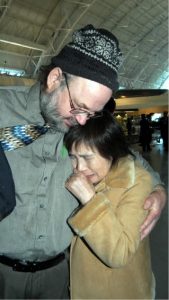My Life—Interview with Keiko Ogura (1937–), interpreter and A-bomb survivor, Part 11: Trip of protest
May 13, 2023
Witnessed diverse aspects of country that dropped the atomic bomb
In December 2003, a restored body of the Enola Gay, the bomber that had dropped the atomic bomb on Hiroshima, was put on display in a new building at the Smithsonian National Air and Space Museum, located in a suburb of Washington, D.C. in the United States.
I visited America on assignment with the Hiroshima prefectural chapter of the Japan Congress against A- and H-Bombs (Gensuikin) as an interpreter for the A-bomb survivor Sunao Tsuboi, in what was a protest against the exhibit. The trip, however, had its difficulties even before we left Japan. Our upcoming visit to the museum was likely reported in the U.S. media, since we started receiving threatening and harassing emails. The messages not only supported the atomic bombing but sometimes included messages such as “Go to hell” written in a creepy, red-purple font. Some encouraging messages also made it to us, but I left Japan still feeling anxious about the visit.
When we arrived, outside the museum people angrily shouted, “Go home; go home.” Once we set foot in the museum building, I flinched at the sight of the huge body of the Enola Gay. I also saw a small fighter jet displayed proudly. That second plane reminded me of the horrible memory of a strafing raid I had experienced in my childhood, making me so fearful that I had to cling to a man standing near me. It was the same model of plane that had attacked defenseless people from the sky above. Sobbing continuously, I was unable to handle my interpretation work.
Mr. Tsuboi drew near the Enola Gay and glared. “This is disgusting,” he said, while I was still stuck in place. After some time, I approached the aircraft with tears in my eyes. There was no description about the killing of civilians inscribed on the plane’s explanatory panel. American children next to us cheered loudly, without appearing to even imagine the victims of the atomic bombings.
Afterwards, I met a woman who had been staging a continuous sit-in protest against nuclear weapons in front of the White House, regardless of the elements. At a church to which we had been taken, we met a long line of people from different denominations who grasped the hands of each of us, the A-bomb survivors, and said “gomennasai,” apologizing to us in Japanese with tears in their eyes. I witnessed a priest break down in tears. I came to be aware that the United States was a country made up of many different kinds of people, some of whom tried to sincerely apologize for their country’s use of the atomic bombs or dedicated themselves to the anti-nuclear movement, even as others tried to justify the atomic bombings.
We also traveled to New York City and visited the site where one of a series of terrorist attacks took place on September 11, 2001. Invited to the “Family Room” of victims placed in a nearby prefab building, we were at a loss for words when confronted with the deep sorrow of those who had lost loved ones in the attack. I will never forget one member of a victim’s family whose voice shook with anger, saying it was unforgivable that then-U.S. President George Bush used the victims of the terrorist attacks as an excuse for waging war on Iraqi. That trip for me was filled with many opportunities to meet people and make discoveries.
(Originally published on May 13, 2023)








